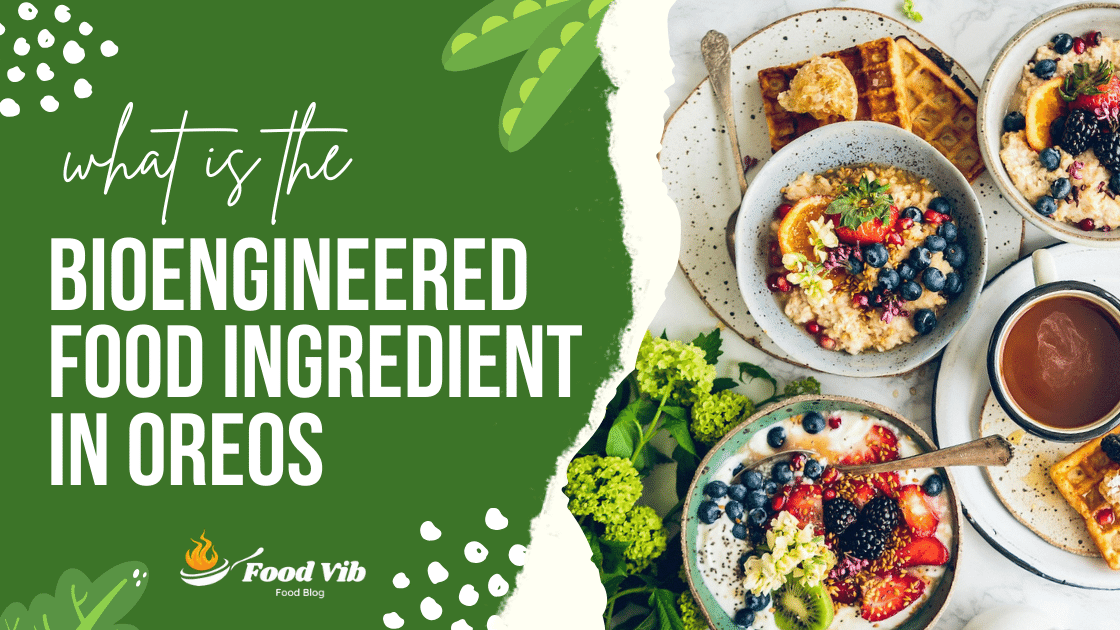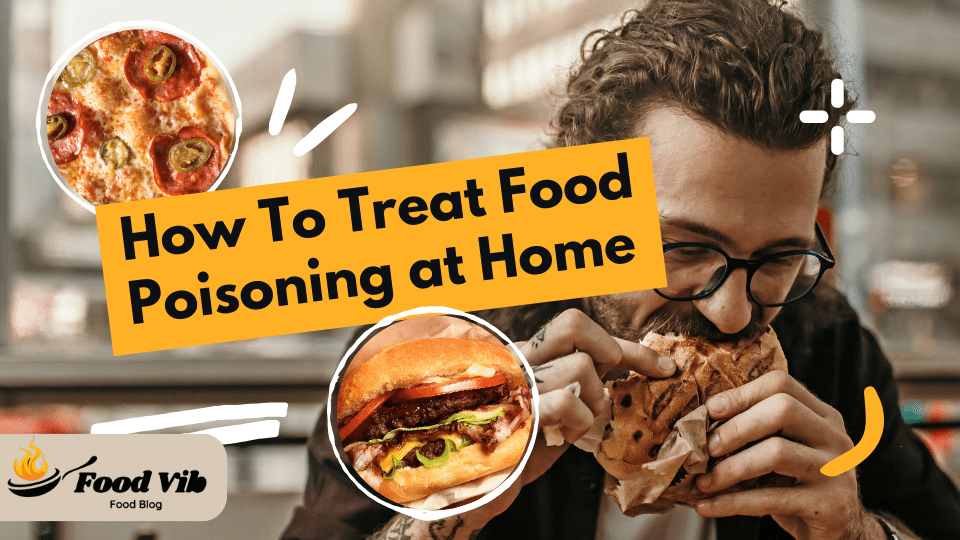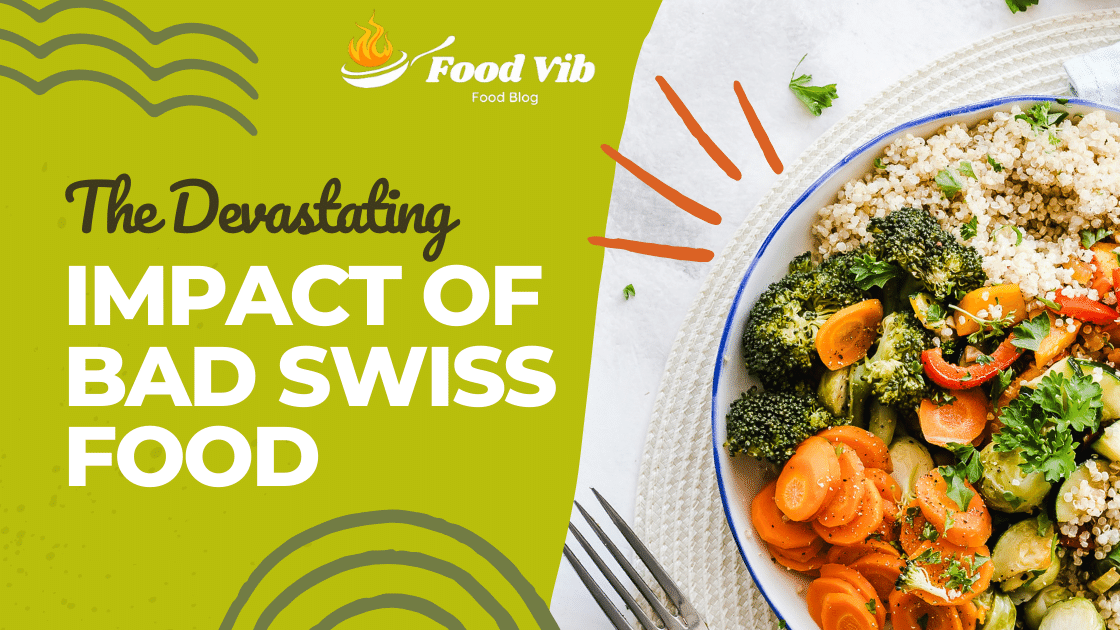Risks of Eating Frozen Food with Broken Seal
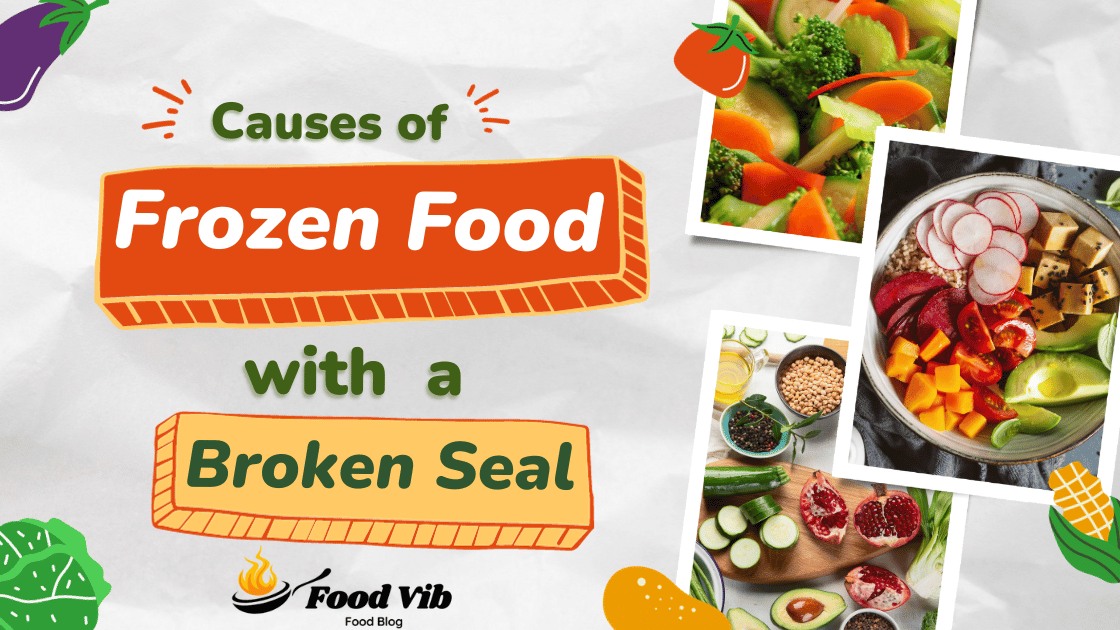
Eating frozen food is a handy and often tasty choice for many people. However, it is important to be aware of the possible risks involved with eating frozen food that has a broken cover. The cover on frozen food packing acts as a protection shield against contaminants and ensures the freshness and safety of the food inside. When this seal is weakened, it can lead to a variety of health risks. Therefore, it is important to understand the risks involved in eating frozen food with a broken seal.

Risks of Eating Frozen Food with Broken Seal
Bacterial Contamination:
When the seal on frozen food is broken, there’s a risk that bacteria from the surrounding world can enter the packaging and contaminate the food. Bacteria like Salmonella, Listeria, and E. coli can grow in such environments and cause deadly diseases.
Spoiling:
The broken cover allows wetness and air to enter the packaging, which can speed the process of food spoiling. This can lead to changes in taste, texture, and odor of the food, making it unpleasant or dangerous to eat.
Loss of Nutritional Value:
Exposure to air and wetness due to a broken cover can cause the food to lose its nutritional value over time. Essential vitamins and minerals may degrade, lowering the total nutritional quality of the food.
Formation of Ice Crystals:
In frozen food, ice crystals help keep the structure and consistency of the product. A broken seal can lead to the formation of big ice crystals or uneven distribution of ice, which can change the taste and quality of the food when it’s warmed and reheating.
Risk of Freezer Burn:
When the seal is broken, the protection layer that stops freezer burn is weakened. Freezer burn happens when food is exposed to air, causing drying and the development of dry, brown spots on the surface of the food. This can affect the taste and appearance of the food.
Cross-Contamination:
If the broken seal allows juices from raw meat or other possibly contaminated foods to leak onto other items in the fridge, it can result in cross-contamination. This increases the chance of foodborne sickness when the contaminated food is eaten.
Unknown Storage Conditions:
A broken cover may suggest that the food has been mistreated or poorly kept, which raises concerns about its safety. It’s possible that the food has been exposed to temperature changes or lengthy exposure to poor conditions, which can compromise its safety and quality.
Chemical infection:
In addition to bacterial infection, a broken seal may subject the food to chemicals or contaminants present in the surroundings. This could occur if the food comes into touch with cleaning agents, chemicals, or other substances that may be present in the freezer or surrounding area.
Legal and Regulatory Concerns:
Consuming food with a broken seal may break food safety rules and guidelines set by health officials. Manufacturers are expected to keep the purity of food packing to ensure the safety and quality of their goods. Eating food with a broken seal could possibly open customers to legal liabilities.
Allergic Reactions:
If the broken seal allows allergens to cross-contaminate with the frozen food, it can pose a major risk to people with food allergies. Even tiny amounts of allergens can cause allergic responses in sensitive people, leading to symptoms ranging from mild pain to life-threatening anaphylaxis.
Must Read: Exploring the Delicious Cuisine of Pittsburgh1
How to Safely Handle Frozen Food with a Broken Seal
Handling frozen food with a broken seal requires extra care to ensure both safety and quality. Here’s a step-by-step guide:
Assess the Situation:
Inspect the frozen food package carefully. Look for any signs of damage or tampering beyond the broken seal. If the package is torn, pierced, or shows signs of melting, it’s best to remove the food.
Gather Supplies:
Get a pair of food-safe gloves, a clean towel or paper towels, a leak-proof container or bag, and a thermometer.
Protect Yourself:
Put on the food-safe gloves to avoid any possible exposure.
Contain the Food:
If the broken seal has caused any leaking or if the package is damaged, move the food to a clean, leak-proof container or bag.
Check Temperature:
Verify the temperature of the food with a thermometer. Frozen food should be at or below 0°F (-18°C). If the temperature is higher, it may indicate melting and possible spoiling.
Thawed Food Inspection:
If the food has thawed or partly thawed, check it closely. Look for any odd smells, changes in texture, or stains. If the food looks to be bad, dump it quickly.
Cook quickly:
If the food is still frozen and looks to be in good shape, cook it quickly. Thorough cooking can kill most germs that may have affected the food.
freezing:
If you plan to eat the food without cooking directly, thaw it safely in the refrigerator, under cold water, or in the microwave following suggested freezing ways to reduce the risk of germ growth.
Use as Directed:
Follow any cooking or preparation instructions on the box or given by the maker.
watch Health:
After eating the food, watch yourself and others for any signs of foodborne sickness. Symptoms may include nausea, vomiting, diarrhea, fever, or stomach pain. If you experience any of these signs, seek medical care.
Clean Up:
Dispose of any packaging or materials used for handling the food carefully. Clean and sanitize any surfaces, tools, or objects that came into touch with the food.
avoid Future events:
Take steps to avoid similar events in the future. Check the stability of frozen food packaging before buying, and handle frozen food with care to avoid damage to seals.
By following these steps, you can safely handle frozen food with a broken seal, reducing the risk of foodborne illness and ensuring the quality of the food you eat.
Must Read: The Surprising Reasons Chinese Food Makes You Hungry
10 Common Causes of Frozen Food with a Broken Seal
Modern culinary conveniences like frozen food have completely changed how we prepare meals. On the other hand, shoppers all too often suffer the disappointment of finding a broken seal on their frozen items. In this thorough investigation, we solve the puzzles around this widespread problem and pinpoint the ten typical offenders that lead to frozen food packaging problems.
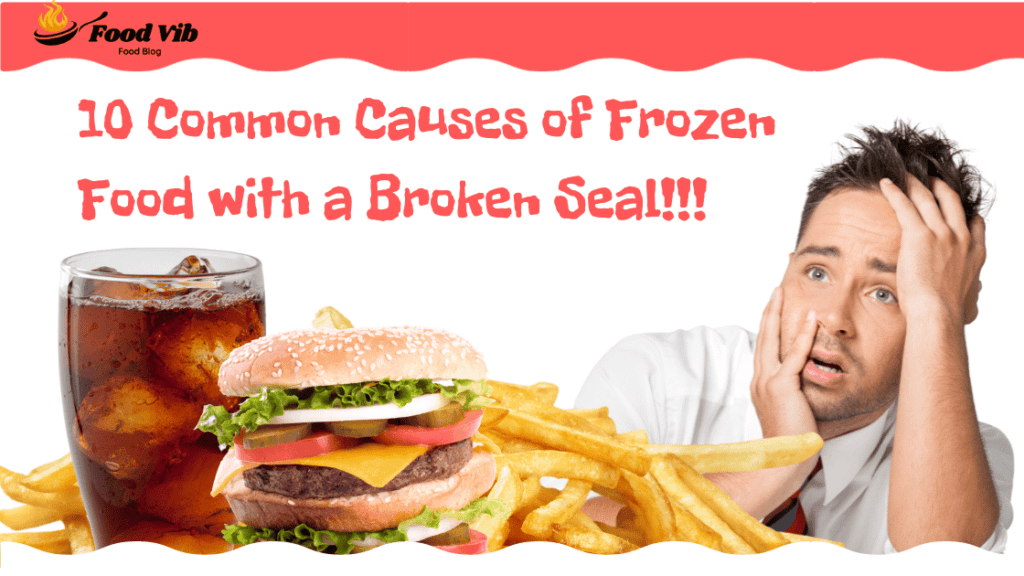
1. Temperature Traumas
Temperature changes are the number one enemy of frozen foods anywhere. Abrupt temperature fluctuations during storage and transit might upset the delicate balance needed for frozen food preservation. This mismatch eventually causes a damaged seal by weakening the packaging’s structural integrity.
2. Rough Rides in Transit
There are several transportation phases involved in the trip from the producing site to the freezer of the customer. Unfortunately, the packing may sustain physical damage from harsh handling during loading, unloading, or even during travel. The outcome? is a cracked seal that reduces the protective layers of the packaging’s efficacy.
3. Material Matters: Packaging Quality
Not every material used in packing is made equally. The strength of the packing is largely dependent on the quality of the materials utilized. Poor quality materials are a weak point in the fight against broken seals because they are more prone to deterioration.
4. Crushing Companions in the Freezer
Frozen food packets often coexist alongside a variety of items in the freezer. Sadly, disorganized freezer contents might cause packages to collapse beneath the weight of other goods. Over time, this physical strain on the packaging may cause a seal to become damaged.
5. Frosty Foes: Freezer Burn
The subtle danger of freezer burn presents a long-term risk to frozen food packing, even though it is not the immediate cause. When ice crystals develop on the food’s surface, the seal may be compromised, letting outside substances seep in and deteriorate the food’s contents.
6. Packaging Predicaments During Production
Sometimes the problems start just where they are. Packaging flaws that don’t show up right away might be caused by inadequate quality control throughout manufacture. Strict quality control measures must be used by manufacturers to identify these problems before the items are released into the market.
7. Seal of Approval: Application Errors
If not used properly, even the most sophisticated packing materials might become problematic. Incomplete seals or uneven heat application are examples of sealing process errors that might result in weak spots that are vulnerable to failure. When applying sealants, accuracy is crucial.
8. Pest Perils
Rats and insects may make unpleasant visitors in storage facilities. In addition to the apparent hygienic issues, these bugs can physically harm packaging, opening up pathways for pollutants and air to enter. It is essential to implement routine pest control procedures to protect frozen food packaging integrity.
9. Transit Time Troubles
Temperature variations might increase the dangers associated with longer travel durations. The longer frozen food is transported, the higher the chance that it may come into contact with adverse weather conditions. To reduce these dangers, transportation must be quick and effective.
10. Consumer Handling Habits
Last but not least, maintaining the integrity of frozen food packaging is greatly aided by the final consumer. Careless handling while putting things in the freezer or rough treatment during supermarket delivery may also lead to broken seals. To minimize these occurrences, consumer education on appropriate handling is essential.
Conclusion: A Frozen Revolution, Safeguarded
A broken seal in the world of frozen goods compromises the whole preservation mechanism, making it more than just a little annoyance. Comprehending the wide range of variables that contribute to this problem enables both producers and customers to take preventative action. We can all work together to guarantee that frozen food maintains its quality from manufacturing to consumption by addressing these common factors.
Must Read: The Ultimate List of Foods Without Calcium and Iron
FAQ (Frequently Asked Question)
What risks are associated with consuming frozen food with a broken seal?
Eating frozen food that has a broken seal puts you at risk for freezer burn, bacterial contamination, and diminished freshness. All of these things may compromise the food's quality and safety.
How can I determine if the safety seal on frozen food is broken?
The best course of action is to look for any obvious damage or seal holes on the box. It's best to avoid eating frozen food if there are rips, holes, or indications of manipulation.
Can I eat something if the seal is broken?
In general, eating any food item with a broken seal is not advised. A broken seal raises the possibility of contamination and spoiling since the seal serves as a barrier of defense.
What happens if the safety seal is broken on frozen vegetables or fruits?
Freezer burn, texture loss, and possible contamination may result from frozen fruits or vegetables that have had their safety seal broken. It is advisable to get rid of these things.
Is it safe to eat yogurt if the seal is broken?
No, it is not recommended to eat yogurt that has a broken seal. Yogurt with a damaged seal may be contaminated, which compromises its freshness and safety.
Should I be concerned if the seal on ice cream is broken?
In response, it is true that ice cream with a broken seal raises questions regarding possible contamination and quality loss. It is advised not to eat ice cream that has a broken seal.
How does a broken seal affect the safety of frozen seafood or meat?
To increase the danger of freezer burn and bacterial infection, a broken seal on frozen meat or seafood may expose the contents to air. It is essential to dispose of these things.
What steps should I take if I discover a broken seal on frozen food?
Don't eat the food if you see a broken seal. To avoid posing any health dangers, dispose of the object safely. You might try reporting the problem to the retailer where you bought it.
Is the soda bottle seal broken?
In response, a cracked seal on a soda bottle might be a sign of contamination or tampering. It is advised that you return the beverage to the retailer for a replacement and do not drink it.

